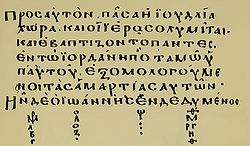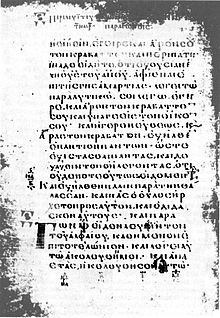- Codex Basilensis A. N. III. 12
-
New Testament manuscripts
papyri • uncials • minuscules • lectionariesUncial 07
Mark 1:5-6 (facsimile edition)Name Codex Basilensis Sign Ee Text Gospels Date 8th century Script Greek Found 1431 Now at Basel University Library Size 23 cm by 16.5 cm Type Byzantine text-type Category V Hand carefully written Note member of Family E Codex Basilensis designated by Ee or 07 (in the Gregory-Aland numbering), ε 55 (von Soden), is a Greek uncial manuscript of the four Gospels, dated paleographically to the 8th century (Burgon suggested the 7th century, Palau the 9th century). The codex is located, as its name indicates, in Basel.[1] The manuscript is lacunose, it has marginalia, and was adapted for liturgical reading.
It contains all spurious biblical passages, but they are marked as a doubtful.
Contents
Description
The text is written in one column per page, 23 and more lines per page. The codex contains 318 parchment leaves (size 23 cm by 16.5 cm), with almost complete text of the four Gospels.[1] The Gospel of Luke contains five small lacunae (1:69-2:4, 3:4-15, 12:58-13:12, 15:8-20, 24:47-end). Three of them were supplied by a later, cursive hand (1:69-2:4, 12:58-13:12, 15:8-20).[2] The text is written in 1 column per page, 24 lines per page.[1] The letters Θ Ε Ο Σ are round, the strokes of Χ Ζ Ξ are not prolonged below the line. It has a regular system of punctuation.[3]
Certain disputed passages are marked with an asterisks – Matthew 16:2b-3 (signs of the times), Luke 22:43-44 (Christ agony), Luke 23:34, Pericope Adulterae (John 8:2-11).[4][5]
It contains the tables of the κεφαλαια (tables of contents) before each Gospel, the text is divided according to the κεφαλαια (chapters), which numerals are placed at the margin. The text is also divided into much smaller the Ammonian Sections with references to the Eusebian Canons (written below Ammonian Section numbers), and the harmony at the foot of the pages,[6] although full references to all parallel texts are given on the margin and the tables are not needed.[2] It is written carefully and well. The initial letters at the beginning sections stand out on the margin as in codices A, C.[7]
The codex was bound together with the minuscule codex 2087 – which contains portions of the Apocalypse, written in the twelfth century. Three leaves of the codex are palimpsests (folio 160, 207, 214).[2][8]
Text
The Greek text of this codex is a representative of the Byzantine text-type.[9] According to Kurt and Barbara Aland it agrees with the Byzantine text-type 209 times, and 107 times with the Byzantine when it has the same reading as the original text. Only one reading agrees with the original text against the Byzantine. It has only 9 independent or distinctive readings. Alands placed its text in Category V.[1]
It belongs to the textual Family E (the early Byzantine text). It stands in in a close relationship to the Codex Nanianus, and the Codex Athous Dionysiou.[10][11] Probably it is the oldest manuscript with a pure Byzantine text (with almost a complete text of the Gospels) and it is one of the most important witnesses of the Byzantine text-type.[5]
In Matthew 8:13 it has interpolation – marked by asterisk – και υποστρεψας ο εκατονταρχος εις τον οικον αυτου εν αυτη τη ωρα ευρεν τον παιδα υγιαινοντα (and when the centurion returned to the house in that hour, he found the slave well). The reading of the codex is supported by: Codex Sinaiticus, Ephraemi Rescriptus, Codex Campianus, (Petropolitanus Purpureus), Codex Nanianus, Codex Koridethi, (0250), f1, (33, 1241), g1, syrh.[12][13]
- Some textual variants
The words after the bracket, are the reading of the codex (against Textus Receptus)
Mark 5:9 — λεγει αυτω ] απεκριθη λεγων[14]
John 1:22 — βηθαραβα ] βηθανια[15]
John 1:28 — τις ] συ[16]
John 4:1 — ο Ιησουυς ] ο Κυριος[17]
John 5:44 — ανθρωπων ] αλληλων[18]
John 8:9 — οι δε ακουσαντες εξερχοντο εις καθ εις ] οι δε ακουσαντες και υπο της συνειδησεως ελεγχομενοι εξερχοντο εις καθ εις[19]
John 10:8 — ηλθων προ εμου ] ηλθων[20]
History
It is a commonly accepted that the manuscript was written in the 8th century, according to Guglielmo Cavallo in the early 8th century.[21] Some former palaeographers proposed even the 7th century (Dean Burgon), but according to Cataldi Palau it was written later in the 9th century. From the palaeographical point of view it looks older, but the regularity of the accentuation and the abundant colourful decoration, are uncharacteristic for the eighth century. The number of errors is remarkable small. According to Palau it was copied by a non-Greek, probably Latin scribe, in the 9th century, in an Italian location.[22]
It probably was brought to Basel by Cardinal Ragusio (1380–1443),[2] who probably brought it from Constantinople[6] when he visited the Council of Florence in 1431. It might have been a present from the Byzantine emperor. In time of that council several other manuscripts came to Europe from Byzantium: Codex Basiliensis A.N.IV.2, Minuscule 10, and probably Codex Vaticanus. In 1559 it was presented to the monastery of the Preaching Friars.[2]
The codex was available to Erasmus for his New Testament, but he never used it. Probably the brethren of the monastery where it was kept, were unaware of its existence. It was transferred to the public library in 1559. The manuscript was used by John Mill in his edition of the Greek New Testament. The text of the manuscript was collated by Wettstein.[23] The manuscript is cited in the printed editions of the Greek New Testament since the 18th century.[24]
Now it is housed in the Basel University Library (A. N. III. 12), Switzerland.[1][25] Formerly it was held under the shelf-number B VI. 21 then K IV. 35.[26]
See also
References
- ^ a b c d e Aland, Kurt; and Barbara Aland; Erroll F. Rhodes (trans.) (1995). The Text of the New Testament: An Introduction to the Critical Editions and to the Theory and Practice of Modern Textual Criticism. Grand Rapids: William B. Eerdmans Publishing Company. p. 110. ISBN 978-08028-4098-L. http://books.google.com/books?id=2pYDsAhUOxAC&printsec=frontcover&source=gbs_ge_summary_r&cad=0#v=onepage&q&f=false.
- ^ a b c d e Gregory, Caspar René (1900). Textkritik des Neuen Testaments. 1. Leipzig: J.C. Hinrichs’sche Buchhandlung. p. 48. http://www.archive.org/stream/textkritikdesne00greggoog#page/n61/mode/2up.
- ^ J. L. Hug, Introduction to the New Testament, trans. D. Fosdick, (Andover 1836), p. 174.
- ^ Scrivener, Frederick Henry Ambrose; Edward Miller (1894). A Plain Introduction to the Criticism of the New Testament. 1 (4th ed.). London: George Bell & Sons. p. 133.
- ^ a b Codex Basilensis E (07): at the Encyclopedia of Textual Criticism
- ^ a b Scrivener, Frederick Henry Ambrose; Edward Miller (1894). A Plain Introduction to the Criticism of the New Testament. 1 (4th ed.). London: George Bell & Sons. p. 131.
- ^ Scrivener, Frederick Henry Ambrose; Edward Miller (1894). A Plain Introduction to the Criticism of the New Testament. 1 (4th ed.). London: George Bell & Sons. p. 132.
- ^ Annaclara Cataldi Palau, “A Little Known Manuscript of the Gospels in: ‘Maiuscola biblica’: Basil. Gr A. N. III. 12,” Byzantion 74 (2004): 463-516.
- ^ Metzger, Bruce M.; Ehrman, Bart D. (2005). The Text of the New Testament: Its Transmission, Corruption and Restoration (4 ed.). New York – Oxford: Oxford University Press. p. 74. ISBN 978-0-19-516122-9. http://www.scribd.com/doc/32002991/Text-of-the-New-Testament-Its-Transmission-Corruption-Restoration.
- ^ Russell Champlin, Family E and Its Allies in Matthew (Studies and Documents, XXIII; Salt Lake City, UT, 1967).
- ^ J. Greelings, Family E and Its Allies in Mark (Studies and Documents, XXXI; Salt Lake City, UT, 1968).
- ^ Eberhard Nestle, Erwin Nestle, Barbara Aland and Kurt Aland (eds), Novum Testamentum Graece, 26th edition, (Stuttgart: Deutsche Bibelgesellschaft, 1991), p. 18.
- ^ Tischendorf C. v., Editio octava critica maior, p. 37.
- ^ Eberhard Nestle, Erwin Nestle, Barbara Aland and Kurt Aland (eds), Novum Testamentum Graece, 26th edition, (Stuttgart: Deutsche Bibelgesellschaft, 1991), p. 102.
- ^ The Gospel According to John in the Byzantine Tradition (Deutsche Bibelgesellschaft: Stuttgart 2007), s. 6.
- ^ The Gospel According to John in the Byzantine Tradition (Deutsche Bibelgesellschaft: Stuttgart 2007), s. 5.
- ^ The Gospel According to John in the Byzantine Tradition (Deutsche Bibelgesellschaft: Stuttgart 2007), s. 30.
- ^ The Gospel According to John in the Byzantine Tradition (Deutsche Bibelgesellschaft: Stuttgart 2007), s. 55.
- ^ The Greek New Testament, ed. K. Aland, A. Black, C. M. Martini, B. M. Metzger, and A. Wikgren, in cooperation with INTF, United Bible Societies, 3rd edition, (Stuttgart 1983), p. 357.
- ^ The Gospel According to John in the Byzantine Tradition (Deutsche Bibelgesellschaft: Stuttgart 2007), s. 133.
- ^ Guglielmo Cavallo: Ricerche sulla maiuscola biblica, Florenz 1967.
- ^ A. Cataldi Palau, “A Little Known Manuscript of the Gospels in ‘Maiuscola biblica’: Basil. Gr A. N. III. 12,” Byzantion 74 (2004), p. 506.
- ^ Wettstein, Johann Jakob (1751) (in Latin). Novum Testamentum Graecum editionis receptae cum lectionibus variantibus codicum manuscripts. 1. Amsterdam: Ex Officina Dommeriana. pp. 38–40. http://www.archive.org/stream/hekainediatheken00clem#page/38/mode/2up. Retrieved November 14 2010.
- ^ Aland, K.; Black, M.; C. M. Martini, B. Metzger, A. Wikgren (1983). The Greek New Testament (3 ed.). Stuttgart: United Bible Societies. p. XV. [UBS3]
- ^ "Liste Handschriften". Münster: Institute for New Testament Textual Research. http://intf.uni-muenster.de/vmr/NTVMR/ListeHandschriften.php. Retrieved 8 March 2011.
- ^ Tischendorf, C. v. (1859). Novum Testamentum Graece. Editio Septima. Lipsiae. p. CLVIII. http://www.archive.org/stream/novumtestamentu00tiscgoog#page/n176/mode/2up.
Further reading
- Russell Champlin, Family E and Its Allies in Matthew (Studies and Documents, XXIII; Salt Lake City, UT, 1967).
- J. Greelings, Family E and Its Allies in Mark (Studies and Documents, XXXI; Salt Lake City, UT, 1968).
- J. Greelings, Family E and Its Allies in Luke (Studies and Documents, XXXV; Salt Lake City, UT, 1968).
- F. Wisse, Family E and the Profile Method, Biblica 51, (1970), pp. 67–75.
- Annaclara Cataldi Palau, “A Little Known Manuscript of the Gospels in ‘Maiuscola biblica’: Basil. Gr A. N. III. 12,” Byzantion 74 (2004): 463-516.
External links
- Codex Basilensis E (07): at the Encyclopedia of Textual Criticism
- Codex Basilensis E (07): at the Evangelecal Criticism
- "Online copy of the MS". Münster: Institute for New Testament Textual Research. http://intf.uni-muenster.de/vmr/NTVMR/ListeHandschriften.php?ObjID=20007. Retrieved 7 August 2011.
Categories:- Greek New Testament uncials
- 8th-century biblical manuscripts
Wikimedia Foundation. 2010.



